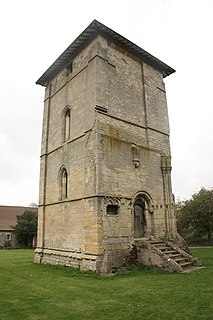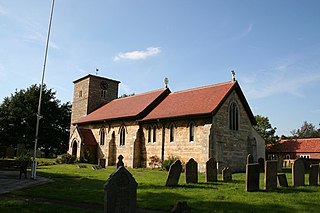Related Research Articles

Temple Bruer Preceptory is a historic building in the civil parish of Temple Bruer with Temple High Grange, North Kesteven, Lincolnshire, England. It is one of the few Knights Templar sites left in England where any ruins remain standing. Its name comes from its Templar ownership and its position in the middle of the Lincoln Heath, bruyère (heather) from the French language current at the time. It was founded in the period 1150 to 1160 and the order was dissolved in 1312. The site is located between the A15 and A607 roads, 2.5 miles (4.0 km) north from Cranwell. The site has been excavated twice, firstly by the Rev Dr. G. Oliver, the rector of Scopwick in 1832–3, and in 1908 by Sir William St John Hope.

Eagle is a village in the North Kesteven district of Lincolnshire, England. It is situated 7 miles (11 km) south-west from Lincoln and 2 miles (3.2 km) east from North Scarle. Eagle is part of the civil parish of Eagle and Swinethorpe. The population of the civil parish taken at the 2011 census was 793.

Great Wilbraham Preceptory is a preceptory in Great and Little Wilbraham, Cambridgeshire. Much of the Church of Saint Nicholas at Great Wilbraham dates back to 1226 when a preceptory was established here by the Knights Templar when the manor was given to Alan Martel, who was at that time Templar Master. There is a Templar tombstone hidden away under the tower and a Templar cross on the outside north wall. In the nearby village of Little Wilbraham, at Temple End, an Elizabethan manor house stands on the site of the preceptory. Previous to the ownership of the Templars, the lands were held by monks of Ely. At the dissolution of the Templar order, ownership passed into the hands of the Knights of St John of Jerusalem.

Aslackby Preceptory in Lincolnshire lay to the south-east of Aslackby Church. Until about 1891 a tower, possibly of the preceptory church, together with a vaulted undercroft, survived as part the Temple farmhouse. Temple farmhouse was subsequently rebuilt and a 15th-century window and a stone pinnacle remain in the garden

Rothley Temple, or more correctly Rothley Preceptory, was a preceptory in the village of Rothley, Leicestershire, England, associated with both the Knights Templar and the Knights Hospitaller.

Aslackby and Laughton is a civil parish in the South Kesteven district of Lincolnshire, England. According to the 2001 census the parish had a population of 243, in 102 households. increasing slightly to 251 in 118 households at the 2011 census. It consists of the village of Aslackby, the hamlet of Laughton, and scattered farms, and part of the hamlet of Graby.

Temple Ewell is a civil parish and historic village in the county of Kent, England. The village is part of the Dover district of Kent, and forms part of the Dover urban area. It is situated three miles North West of the town of Dover.

Rothley Court is a country house at Rothley in Leicestershire, England. It was mentioned in the Domesday Book and later, as Rothley Temple, associated with the Knights Templar. At the Dissolution it became a private house and the seat of the Babington family; Thomas Babington Macaulay was born there in 1800. It now functions as the Rothley Court Hotel.
Temple Guiting Preceptory was a medieval monastic house of the Knights Templar in Gloucestershire, England. It was founded around the middle of the twelfth century, receiving grants of land from Gilbert de Lacy and Roger de Waterville. Following the closure of the order in 1308–1309, the last preceptor of Guiting was sent to a monastery in the Diocese of Worcester with a small maintenance charged upon the lands of Temple Guiting.
Great Limber Preceptory, Limber Magna was a Camera (farm) of the Knights Templar and later the Knights Hospitaller in the village of Great Limber, Lincolnshire, England.
Horkstow Camera was a monastic cell in Lincolnshire, England, dependent on Willoughton Preceptory, a house of the Knights Templar.

Ribston Preceptory was a priory just east of the village of Little Ribston, in North Yorkshire, England on the east bank of the River Nidd. The preceptory at Ribston was founded in 1217, when Robert de Ros donated the land and advowson of Ribston to the Knights Templar.
The history of the Knights Templar in England began when the French nobleman Hughes de Payens, the founder and Grand Master of the order of the Knights Templar, visited the country in 1128 to raise men and money for the Crusades.

Temple Manor is a scheduled ancient monument and grade I listed building in Strood, Kent. The Manor has been owned by various religious, national and farming owners over 600 years. The building has been added to and adapted over the centuries, but the basic structure is now clearly visible.

Withham Preceptory, one of the smallest Knights Templar preceptories in England, was founded, before 1164, at Temple Hill, near South Witham, Lincolnshire, and was abandoned in the early 14th century. The site of the former preceptory at Temple Hill, South Witham. It 'has been largely under pasture' since the Knights Templar left in 1308.

The Anglican Church of St Mary at Templecombe, within the English county of Somerset, was built in the 12th century and is a Grade II* listed building.

The Knights Templar Church in Dover is the ruins of a medieval church on Bredenstone hill, part of the Dover Western Heights in Kent, England. It has been designated by English Heritage as a scheduled monument.

Temple Hirst is a village and civil parish in the Selby District of North Yorkshire, England. It was formerly in the wapentake of Barkston Ash in the West Riding of Yorkshire. The village is located on the north bank of the River Aire. In the 2011 census the population was 117.
References
Coordinates: 51°9′44″N1°16′16″E / 51.16222°N 1.27111°E